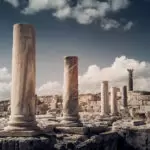
Out of all the ways we power the planet, nuclear energy may be the most divisive. When it first began as an offshoot of nuclear weapons programs, it seemed to promise unlimited electricity that would power a new atomic age. The first nuclear power plant came online in the USSR in 1954, followed three years later by the first nuclear power plant in the US. Yet by the 1970s there was strong opposition to nuclear power in many countries. The reactor meltdown at Three Mile Island in 1979, and later Chernobyl in 1986, effectively put a stop to widespread construction of new power plants.
Yet there are still over 400 nuclear power plants in operation today, with over sixty more on the drawing board, about half of which are to be built in China. About 12% of the world's electricity comes from nuclear reactors, and that number is likely to increase as more governments grapple with how to manage energy security while reducing the air pollution and greenhouse gases of convention fossil fuels.
Nuclear Power Technology
In many ways, generating electricity with a nuclear reactor is very similar to generating electricity in a coal-fired power plant, albeit vastly more complicated.
Uranium ore is first mined, then enriched to increase the amount of the isotope uranium-235, which is capable of sustaining a nuclear chain reaction. Pellets of enriched uranium are lined up in rows to form fuel rods and then placed in the reactor. Fire a neutron into a uranium-235 nucleus, and it will split, ejecting neutrons into other uranium atoms, creating a chain reaction. Splitting these atoms releases a huge amount of heat and radiation. Then, just as in a coal plant, the heat is used to turn water into steam, which turns a turbine that cranks an electrical generator.
Depending on the reactor design, the fuel rods are either recycled to produce new fuel, or removed as waste and disposed of in storage tanks. In the US, there is continued debate over a central waste depository, like the proposed Yucca Mountain site in Nevada. Currently, most nuclear waste is kept at the reactor site. The spent fuel rods contain a range of elements with half-lives of thousands to millions of years. Plutonium, one byproduct of the reaction, has a half-life of 24,100 years.
Most reactors are light water reactors, meaning that water is used as a coolant and to moderate the speed of the fission reaction. Other types of reactors, though not as common, use other substances for coolants, moderators, and other processes. One type worth mentioning, though, is fast breeder reactors, which have the potential to reduce current stockpiles of nuclear waste by using them in the reactor.
Advantage & Disadvantages
Nuclear power is a very powerful, efficient form of generating energy. It's reliable and continuous, so it doesn't suffer the intermittency problems that wind and solar sometimes have. It doesn't produce any greenhouse gases or air pollutants. It can help reduce the amount of weapons grade uranium from nuclear missiles by using the uranium as fuel.
The disadvantages, though, can be summed up in one word: radiation. Disposal of spent fuel waste is a major issue, with an average power plant generating 20 tons of spent fuel each year. Currently the US has no viable long-term storage solution. Less well known is the problem of disposing of low level nuclear waste like contaminated clothes and equipment. And while nuclear power plants in general have an excellent track record for safety, when there is a major accident, it can have worldwide repercussions.
Capacity
Thirty-one countries have at least one operating nuclear power plant. Together, they produce about 375 GW of power. The U.S. is the current leader in nuclear power plants, which generate about 19% of the country's electricity. France has the highest percentage of electricity generated from nuclear power.
The top five countries using nuclear power are:
- U.S.A. 99 GW
- France 63 GW
- Japan 42 GW
- Russia 23 GW
- South Korea 21 GW
Future Trends
Despite the controversy over nuclear power, many countries are pressing ahead to build new, more advanced kinds of reactors. Known as Generation IV reactors, they are designed with increased safety measures and are more efficient than current reactors. Researchers are also working on reactors that use alternate kinds of fuel, like thorium. Developing better methods of waste storage is a key problem to overcome in the coming decades. Read more about nuclear power facts.
Careers in Nuclear Power
The nuclear industry employs thousands of nuclear engineers, technicians, plant operators, and more. There are many non-nuclear-related careers as well. Environmental engineers work to improve the safety of nuclear waste storage. Environmental lawyers shepherd new plants through the many steps of the regulatory process.
- Nuclear Energy 101 - December 1, 2014
- Wind Power 101 - November 30, 2014
- Natural Gas 101: Pros & Cons - October 24, 2014
Related Articles
Featured Article

Cartography: More Than a View From Above





